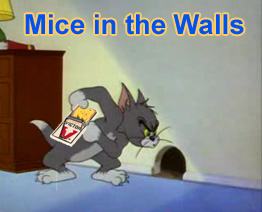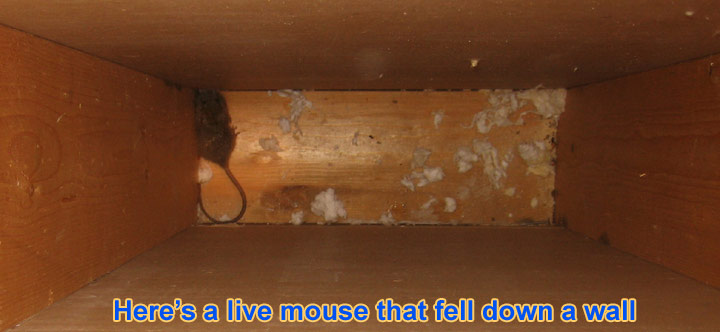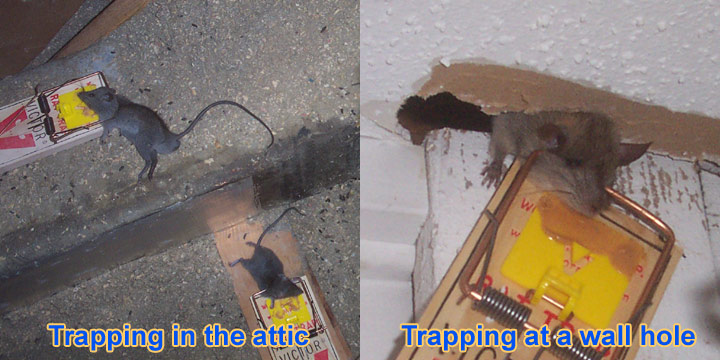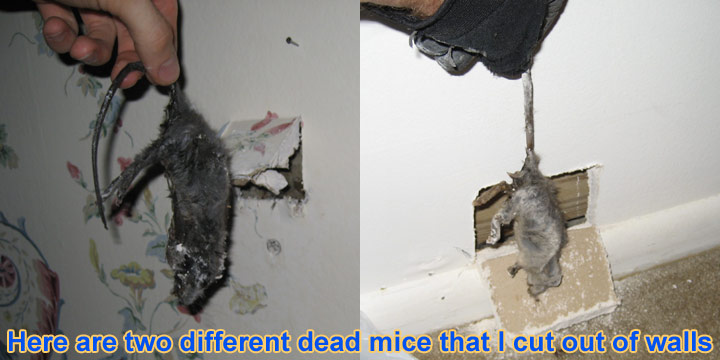-
info@aaanimalcontrol.com
Call us for help in your town
Humane Wildlife Education
Mice in the Wall - How to Get a Mouse Out of Your Walls
Need PERMANENT mouse removal in your town? Click here for a mouse removal price quote in your town - we service over 500 USA cities/towns as of 2020
and specialize in 100% permanent rodent removal within a week. No wasting time with poisons!
To do it yourself, follow the below 4-step process exactly. After you read the below information, you may want to click on one of these guides that I wrote:
How much does mouse removal cost? - get the lowdown on our prices.
How to get rid of mice - my main DIY mouse removal info guide.
 So! You've got mice in your walls or a mouse in your wall of your home! How do you know? Most likely, you don't see a large hole at your
living room baseboard. You hear the pitter-patter of little feet scampering up and down the wall, or scratching
at the bottom of the wall. Or perhaps you have seen evidence of mice, such as chewing at the wall, or small droppings, like little brown grains of rice. Or perhaps the mice have gotten into your pantry, and are chewing up the food, and
you can see entry holes chewed in the wall.
So! You've got mice in your walls or a mouse in your wall of your home! How do you know? Most likely, you don't see a large hole at your
living room baseboard. You hear the pitter-patter of little feet scampering up and down the wall, or scratching
at the bottom of the wall. Or perhaps you have seen evidence of mice, such as chewing at the wall, or small droppings, like little brown grains of rice. Or perhaps the mice have gotten into your pantry, and are chewing up the food, and
you can see entry holes chewed in the wall.
This guide will help you
solve your problem with mice, by examining the proper mouse control techniques
for permanent mouse removal.
Click to: See Mouse Trapping Photos - Hire a Mouse Pro in Your Hometown - Read Mouse in the Wall Stories.
How Did Mice Get Inside My Wall? Well, first, they got inside your home or building. Mice can fit through amazingly small holes, as small as a dime, or a half-inch gap in the architecture. The can climb pretty much any surface, and enter the house
from the ground level to the roof. So the mouse in the wall may have entered the home near the base and crawled up, or entered near the roof, and crawled down from the attic into the walls.
What do mice do once inside the house or walls? The just use the area as a safe place to live. And while they're at it, they chew on wood, chew on electrical wires (a potential fire hazard), they poop and pee everywhere (which is not only unsanitary, but
the odor attracts new rats to the area), and they often chew their way into the house to find their way to the kitchen or other food sources. They also spread disease. They reproduce quickly, and will create mouse nests in the wall or in the attic.
I've cut open walls at several homes and found rat nests inside, with many baby mice.

I took the above photograph from inside the attic of a home. This mouse fell down, and can't climb these slick surfaces back up. But almost all of the time, the mice can climb, or they've gone down a wall with a pipe, or electrical wire, or they can move laterally
from wall to wall to find areas to climb up.
The 4-Step guide for getting mice out of the walls:
- Step 1 - Inspect the entire exterior of the house or building, and find any and all entry holes, as small as 1/4 inch. THIS IS VERY HARD. Mice can fit through very small openings and gaps and they can climb anything, so you have to search everywhere.
- Step 2 - As you find these areas, seal them shut with steel mesh, which mice cannot chew through.
- Step 3 - Only after the home is entirely sealed shut, go into the attic space and set wooden snap traps baited with peanut butter. Location is important: the mice are running up and down your walls and into the attic. Find these places and set the traps there.
- Step 4 - Every day, remove trapped mice bodies, and re-set traps. In just 2 or 3 days, all will be caught.
- SUCCESS - Once you hear no more scurrying noises in the ceiling or walls, you know you've done it!
- FAILURE - If you still have rats, it means you failed steps 1 & 2. You must find the remaining holes.
- WHAT IF A MOUSE IS STUCK? - Mice in walls usually have no problem crawling up and down the wall, via pipes or wires. But if a mouse is truly STUCK, you must get it at the opening at the top of the wall, or cut a hole in the drywall at the bottom.
Okay, so how do I solve the mouse problem? The most important thing, and the only thing that will actually solve the mouse problem is to prevent the mice from ever entering the house or building in the first place! If you can do that, problem solved forever.
If not, the problem will remain forever. No amount of trapping or poisoning will ever solve anything if the open holes leading into your house remain, because new mice will keep coming in, forever. So you must do an extremely detailed inspection of the house, and
seal all entry points shut, using steel, so that mice (who are rodents and expert chewers) can't chew their way back in again. This is very hard work, and it requires a strong knowledge of home architecture, repairs, and mouse behavior, to understand all the areas
mice use to enter the house. It really is the type of work best left to professionals with lots of experience in mouse control.
Then, after you've got everything sealed up, there's still going to be some mice left inside the building, and you must trap and remove them, before they chew their way out somewhere, or die. It's easy to trap mice. Just set a whole lot of wooden snap traps over the
areas they frequently run. On the areas you see lots of mice trails and mouse poop, such as in the photo to the lower left. Or mount the trap right on the wall, next to a hole that the mice have chewed through, such as in the photograph in the lower-right.

Monitor the traps and remove mice as they are caught. When you stop catching mice and stop hearing noises, you know the problem has been solved! If you keep catching mice for more than a week, or keep hearing noises, that means that you failed to find and properly
seal all the entry points, so you'll have to inspect the home all over again. This is the most important part, and the hardest part. FINDING ALL MOUSE ENTRY AREAS IS VERY HARD. Mice can fit through very small openings: as small
as a dime, or gaps as small as 1/4 inch, believe it or not. It's amazing how small a space mice can fit through. And they can climb anything, so you have to search every square inch of the house, from bottom to top of roof. Common entry points include:
- Roof vents or soffit vents
- Eave gaps where eave meet roof
- Bottom of A/C chase
- Loose siding or loose fasia boards
- Unsealed or uncaulked window edges or where brick meets eave
- Anywhere were pipes or vents enter the home

Sometimes mice die in the walls. Either they get stuck and dehydrate and die, but more often, they either die of old age (they rarely live more than 6 months!) or they die as a result of poison placed in the walls or attic by the homeowner or a pest control
company. Never use poison for mouse control! It does not solve the problem, and you're left with stinky, rotting mice in the walls, and then you'll have to endure a stench for a while, or have a company like mine come out and cut the dead mice out of the walls.
How to get mice out of the garage


















